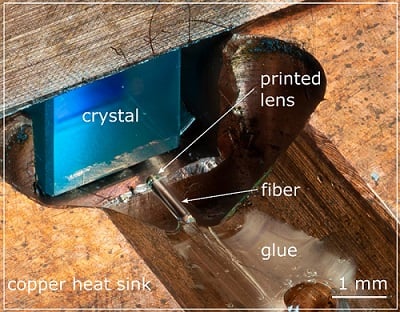Researchers have shown that 3D-printed polymer-based micro-optics can withstand the heat and power levels that occur inside a laser. The advancement enables inexpensive compact and stable laser sources that would be useful in a variety of applications, including the lidar systems used for autonomous vehicles.
The researchers 3D-printed microscale optics directly onto optical fibers to combine fibers and laser crystals inside a single laser oscillator in a compact way. The resulting hybrid laser exhibited stable operation at output powers of over 20 mW at 1063.4 nm and had a maximum output power of 37 mW.
“We significantly reduced the size of a laser by using 3D printing to fabricate high-quality micro-optics directly on glass fibers used inside of lasers,” said research team leader Simon Angstenberger from the 4th Physics Institute at University of Stuttgart in Germany. “This is the first implementation of such 3D-printed optics in a real-world laser, highlighting their high damage threshold and stability.”
Researchers printed microscale lenses directly onto optical fibers, allowing them to compactly combine fibers and laser crystals inside a single laser oscillator. Courtesy of Moritz Floess and Simon Angstenberger/4th Physics Institute at University of Stuttgart in Germany.
The new laser combines the compactness, robustness, and low cost of fiber-based lasers with the advantages of crystal-based solid-state lasers, which can have a broad range of properties such as different powers and colors.
“Until now, 3D-printed optics have primarily been used for low-power applications such as endoscopy,” Angstenberger said. “The ability to use them with high-power applications could be useful for lithography and laser marking, for example. We showed that these 3D micro-optics printed onto fibers can be used to focus large amounts of light down to a single point, which could be useful for medical applications such as precisely destroying cancerous tissue.”
The team uses a 3D-printing approach known as two-photon polymerization, which focuses an infrared laser into a ultraviolet-sensitive photoresist. In the laser’s focal region, two infrared photons will be absorbed simultaneously, which hardens the UV resist. Moving the focus around allows various shapes to be created with high precision. This method use can be used to create miniaturized optics and also allows novel functionalities such as the creation of free-form optics or complex lens systems.
“Because these 3D-printed elements are made of polymers, it was unclear whether they could withstand the significant amount of heat load and optical power that occurs inside a laser cavity,” Angstenberger said. “We found that they are surprisingly stable, and we were not able to observe any kind of damage on the lenses even after several hours of running the laser.”
For the new study, the researchers used a 3D printer made by Nanoscribe to fabricate lenses with a 0.25-mm diameter and 80-µm height onto the end of a fiber with the same diameter using two-photon polymerization. This involved designing an optical element with commercial software, inserting the fiber into the 3D printer, and printing the small structure on the end of the fiber. This process must be extremely precise in terms of aligning the printing to the fiber and the accuracy of the printing itself.
After the printing was complete, the researchers assembled the laser and the laser cavity. Rather than using a crystal inside a laser cavity made of bulky and costly mirrors, they used fibers to form part of the cavity, creating a hybrid fiber-crystal laser. The lenses printed at the end of the fibers focus and collect — or couple — the light into and out of the laser crystal. They then glued the fibers into a mount to make the laser system more stable and less susceptible to air turbulence. The crystal and the printed lenses measured just 5 × 5 cm2.
Continuously recording the laser power over several hours verified that the printed optics inside the system did not deteriorate or affect the long-term properties of the laser. Additionally, scanning electron microscopy images of the optics after use in the laser cavity did not show any visible damage. “Interestingly, we found that the printed optics were more stable than the commercial fiber Bragg grating we used, which ended up limiting our maximum power,” Angstenberger said.
The researchers are now working to optimize the efficiency of the printed optics. Larger fibers with optimized freeform and aspherical lens designs or a combination of lenses printed directly onto the fiber could help improve the output power. They would also like to demonstrate different crystals in the laser, which could allow the output to be customized for specific applications.
Subscribe to AM Chronicle Newsletter to stay connected: https://bit.ly/3fBZ1mP
Follow us on LinkedIn: https://bit.ly/3IjhrFq
Visit for more interesting content on additive manufacturing: https://amchronicle.com


